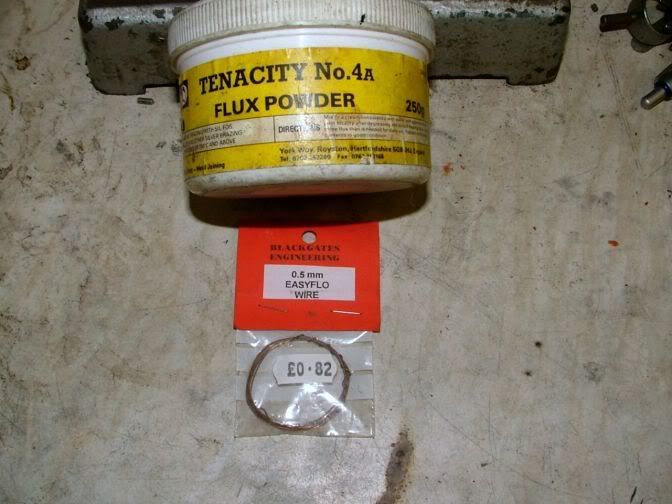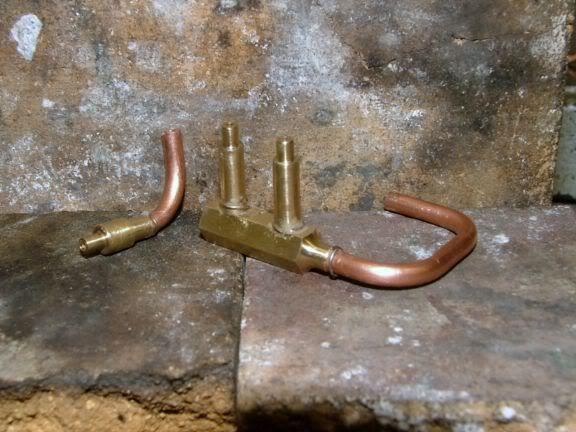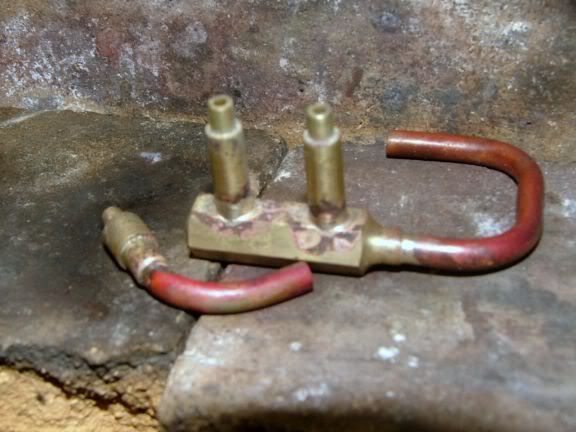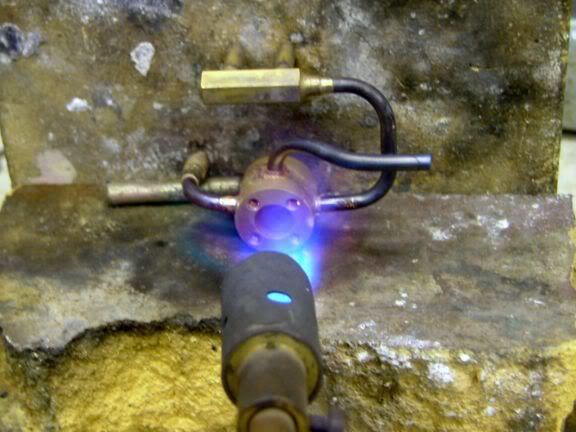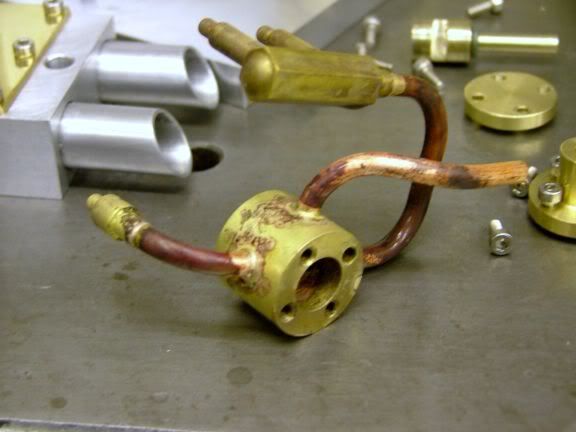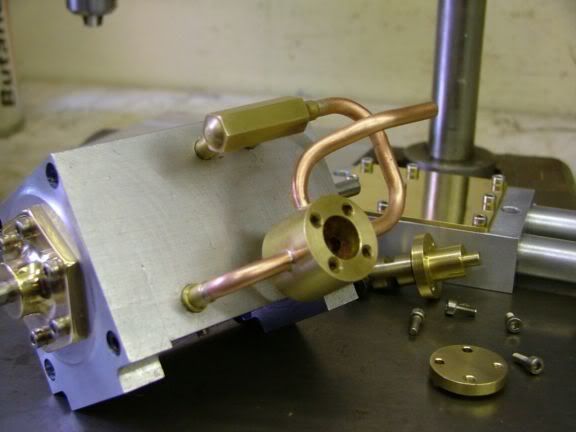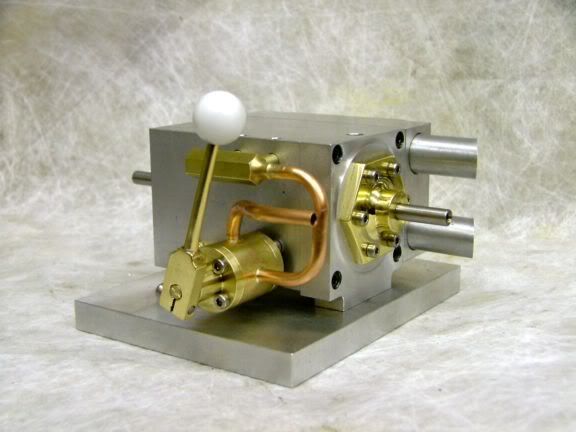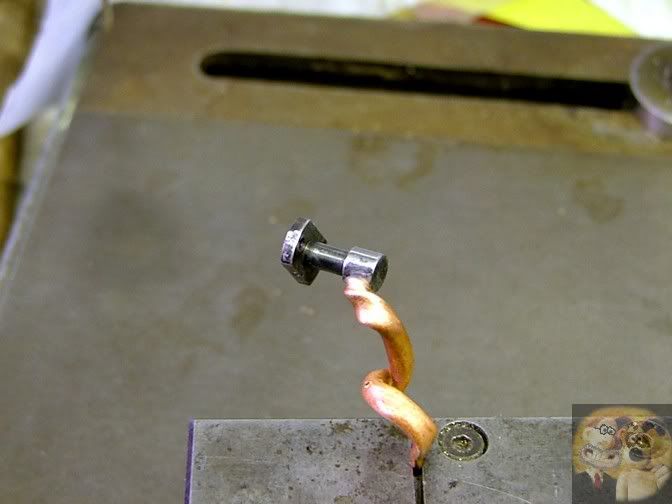Just to answer a few of the queries raised in previous posts.
Why not use soft solder?
To put it bluntly, it is just not a strong enough joint. When working on small engines, vibration has to be taken into account, and with a soft soldered joint, they fail all too often because of this problem.
A good hard soldered joint (silver soldered or as the US call it, silver braze) should be almost indestructible.
I carried out a test to determine how strong the joints were when making steel to copper joints while building my Paddleducks engines, and I think this picture tells all, the joint just wouldn't give way, the actual copper pipe eventually failed.
I forgot to mention about cleanliness, but I have found over the years a very good method.
I clean the joints with carpenters steel wool, this has no oil preservative on it unlike general purpose cheapo wool, which has oil on it to stop it corroding.
So basically, I rub over the joints with wire wool, then wipe everything over with a bit of spirits (denatured alcohol or Isopropanol), I find that this is enough.
Do not use anything that has grit on it, like emery or sandpaper. If any bits come off onto the joint area, it can penetrate and get incorporated into the joint and cause a weak spot, if you get any steel wool in the joint, it just becomes part of the joint.
I personally don't go to great lengths with cleaning purely because I use a perfect flux for this type of work.
Here in the UK, unlike the US and other parts of the world, we have specialists who make such things for industry and model engineering, and you can obtain a variety of fluxes and silver solders to join almost all materials that can be joined by such methods. So for people who are not in the UK, dig deep in your pockets and buy yourself a tub of Tenacity 5 flux, you will never regret it. This flux was designed for silver soldering stainless steel, but it works with everything else. The main advantage is that it cleans the material as it is being heated up and withstands temperatures where other fluxes would have given up and caused a failed joint.
I haven't bought any 1/16" silver solder rods for many many years, it is just too cumbersome to use when confronted with tiny joints, you tend to get the solder everywhere. You need very little solder to form the joint, and any excess is a waste of this expensive item. I use either 0.5mm wire, used as shown in pictures above on my previous post or silver solder sheet, which is about 0.005" thick. This is cut into what are called 'Pallions' using normal scissors, and is placed onto or into the joint, using the flux like a 'glue'. It is then just a matter of heating up the largest part of the job and the solder will automatically flow into the work, giving you perfect joints with no need to file all the excess solder off, as if you have calculated right, there should be no excess at all.
For cleaning up afterwards you use a process called 'pickling'. There are lots of potions and lotions that people use, from heavy highly dangerous acids and alkalis to mothers' pickling vinegar.
You can't go far wrong by going into a brewing shop (in the UK) and buy yourself a kilo of citric acid crystals. This should last you the rest of your life.
I mix it up by using say a pint of warm or hot water, and gently adding the crystals until you see that no more are being absorbed into the water. This stuff is so safe you can just add sugar and feed it to the mother in law as lemonade.
I keep this in a tupperware sealed container and use it until it no longer does it's job.
Just drop the soldered bits into it and leave for about an hour. The parts should come out nice and clean and can be then polished up with a bit of wire wool. Don't worry about leaving it in there too long, the workpiece shouldn't suffer, in fact, I left a part in my pickle for many months, and it didn't suffer any ill effects at all.
For heating the job up to carry out your soldering.
For me, say the job is equal to a 1.5" cube of material or smaller, I would use just a plumbers butane/propane soldering torch, and larger than that, I would get out my larger propane blowtorch that is supplied by a large gas bottle, in fact if it is a really large job, say a loco steam boiler, I would get help and use two blowtorches, a big one for heating the main part of the job and a smaller one for localised heat.
Where many people go wrong is that they don't put enough heat into the job and the solder just won't 'flash' into the joint. This then causes a problem, the solder you have just heated up and turned into a ball on the surface of the job has change properties, the melting temperature will have risen and will require even more heat and flux to get it to remelt.
There is a fine line between too little and too much heat in the job, this is where a long lasting flux is required, it gives you a longer working time. If you heat up just the major part of the job and watch the solder itself, once it has reached the perfect heat, it will 'flash' into the joint, any more heat and you are liable to 'cook' the joint and it will be weak.
So basically, keep an eye on the solder, I sometimes use my tinted driving glasses so that I can see when the solder has flowed, through the glare from the hot metal.
Sometimes it is all over in a few seconds, other times you can spend half an hour getting the job up to working temperature.
NEVER point the torch at the solder, ALWAYS at the major part of the job.
It is all to do with practice and experience, then more practice and experience.
I hope that this has helped a little.
John





